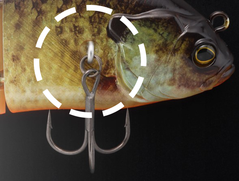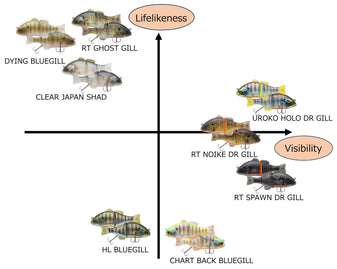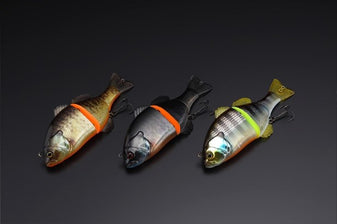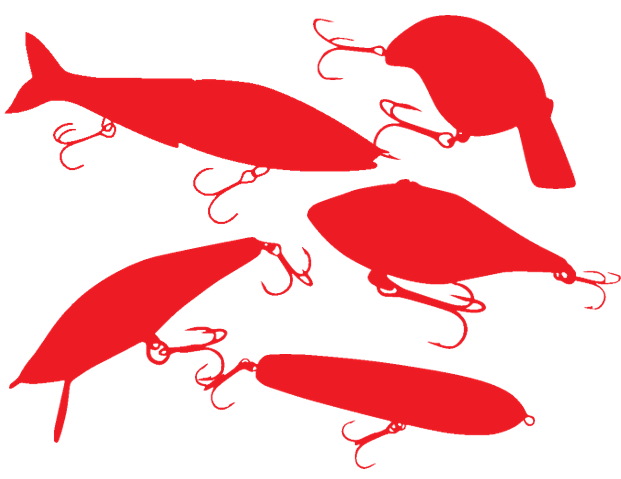Swimming Action
1. A Revolutionary Bluegill-Style Joint Bait: The Sideways Floating Action
Before we explore the unique sideways floating action of the Chibitarel Dead Rise, it's crucial to understand why bluegill-style lures are designed to swim this way, and the significance of a lure’s ability to float back to the surface.
The flat design of bluegill-style lures, allows them to swim sideways, creating a significant water displacement for an effective appeal, leading to a major trend in Japan for a time, with soft-plastic like Deps' Bullflat and other bluegill-inspired baits becoming immensely popular.
There was a period in Japan when soft bluegill-style lures, like Deps' Bull Flat, became immensely popular. However, their soft nature made it difficult to retrieve them back to the surface once they had sunk, making it a challenge to redirect a bass’s attention back to the topwater. In contrast, hard lures can be made to rise back to the surface even after diving down. The Chibitarel Dead Rise was developed to harness this unique property.
The Dead Rise action mimics a dying bluegill as it floats to the surface on its side, creating an irresistible target for hungry bass and marking the Chibitarel Dead Rise as a groundbreaking bluegill-style joint bait.
2. A Foe Yet a Friend? The Complex Relationship Between Bass and Bluegill
Why is there such a close connection between bass fishing and bluegill? For bass, bluegill can be an easy prey, a perfect baitfish, yet sometimes they turn into aggressors, attacking the bass’s own offspring.
As spring arrives, bass engage in spawning behaviors, creating nests for their young. It is during this time that bluegill seize the opportunity to prey on the bass's eggs and fry. In an attempt to ward off the bluegill, bass will actively use their mouths, creating what is known as a "nesting pattern." This interaction highlights the spring bluegill pattern.
Come early summer, the roles are reversed. Bluegill start to spawn and guard their own fry. This period coincides with the bass’s post-spawn phase, making them more aggressive and likely to venture into the shallows in search of food. Bluegill nests are often found in shallow waters, falling right within the bass’s active feeding zones and serving as an excellent source of prey.
This sets the stage for the early summer bluegill pattern, showcasing the effectiveness of bluegill-style lures in bass fishing.
3. Versatile in Every Direction: Stimulating Bass Appetites with Various Approaches
The Chibitarel Dead Rise lure is incredibly versatile, allowing for a range of techniques based on your retrieve speed and rod action
Slow Retrieve: Unique Side-Swimming Action
With a slow retrieve, the lure swims sideways, mimicking a weakened fish. The basic technique here is to use a stop-and-go motion to create a dead rise effect.
Medium Retrieve: Glide swimming action to Attract Bass
At a medium retrieve speed, the lure shifts to a vertical orientation, producing a slalom action. Transitioning from a medium to a slow retrieve, followed by a stop, allows the lure to dead rise sideways, creating the appearance of an exhausted bluegill.
Further Imitation of a Dying Bluegill with Rod and Reel Manipulation
Once you’ve brought the lure to the surface, use reeling and twitching motions to mimic the last spasms of a dying bluegill—a small and subtle shaking motion can be particularly effective. The lure's transition from a lateral movement in response to reeling to a vertical movement as it watches the surface is bound to peak bass interest. Additionally, bass might strike as the lure shifts from vertical to horizontal, so be sure to keep an eye on the lure even as you change your reeling speed.
For diving techniques, we recommend using a 14 to 16-pound fluorocarbon line, while a 14 to 16-pound nylon line is best for surface techniques and subtle movements.
4. A Follow-Up Bait for the Gantarel and the Chibitarel
Jackall presents the Gantarel and Chibitarel as part of its sibling series, both of which are bluegill-style glide baits and served as inspirations for the Chibitarel Dead Rise. These two lures are designed as typical glide baits, making them highly effective at drawing in fish, possibly even more so than the Dead Rise. The basic technique involves a straightforward retrieve followed by a 180-degree turn. When this approach fails to entice a bite, that’s where the Chibitarel Dead Rise comes into play. Even the wiliest bass, wise to the ways of glide movements, may find themselves utterly fooled by the unique Dead Rise action—a sight they’ve never encountered before.
5. Secure Hooking with Side-Placed Hooks and a Swivel Eye to Prevent Fish Escape


In the realm of big bait fishing, where each catch holds substantial value, providing full support to the angler is paramount. The Chibitarel Deadrise differentiates itself from typical lures with its side-placed hooks, ensuring a solid hook-up during surface bites. Additionally, the eye of the lure features a swivel design. This crucial detail prevents the hooks from coming loose during the intense thrashing that often follows hooking a big fish, a common occurrence with big baits.
6. Choose from Eight Different Colors to Suit the Situation.


HL Bluegill and Chartback Bluegill feature more vibrant colors and are highly visible to anglers, making them great choices for murky waters and other situations where increased appeal is necessary.
RT Ghost Gill, Dying Gill, and Clear Japan Shad offer more natural colors. They have a subtler appeal and are less visible, making them ideal for clear waters or situations where bass are likely to be spooked and more discerning about your lure.
RT NOIKE DR Gill, RT Spawn DR Gill, and Uroko Holo DR Gill feature fluorescent paint on the joint sections, acting as visibility markers. These are particularly effective in difficult visibility conditions such as rainy weather or when the water surface is rippled by the wind, making the lure hard to spot.
- Condition: Brand New
- Length: 130 mm (5.1 inch)
- Weight: 42 g (1.5 oz.)

(*depend on country as below)
– Middle East : 9 working days*
– Oceania : 3 to 6 working days*
– Asia 1 to 6 working days*

The largest stock
View All

Reliable quality


![CHIBITAREL DEADRISE [Brand New]](http://jpnfishingtackle.com/cdn/shop/files/4525807241181_1_{width}x.png?v=1719991613)
![CHIBITAREL DEADRISE [Brand New]](http://jpnfishingtackle.com/cdn/shop/files/4525807241150_1_{width}x.png?v=1741327512)
![CHIBITAREL DEADRISE [Brand New]](http://jpnfishingtackle.com/cdn/shop/files/4525807241174_1_{width}x.png?v=1741327512)
![CHIBITAREL DEADRISE [Brand New]](http://jpnfishingtackle.com/cdn/shop/files/4525807241143_1_{width}x.png?v=1741327512)
![CHIBITAREL DEADRISE [Brand New]](http://jpnfishingtackle.com/cdn/shop/files/4525807241204_1_{width}x.png?v=1741327512)
![CHIBITAREL DEADRISE [Brand New]](http://jpnfishingtackle.com/cdn/shop/files/4525807241211_1_{width}x.png?v=1741327512)
![CHIBITAREL DEADRISE [Brand New]](http://jpnfishingtackle.com/cdn/shop/files/4525807241198_1_{width}x.png?v=1741327512)
![CHIBITAREL DEADRISE [Brand New]](http://jpnfishingtackle.com/cdn/shop/files/4525807241167_1_{width}x.png?v=1741327512)
![CHIBITAREL DEADRISE [Brand New]](http://jpnfishingtackle.com/cdn/shop/files/4525807241181_1_160x160.png?v=1719991613)
![CHIBITAREL DEADRISE [Brand New]](http://jpnfishingtackle.com/cdn/shop/files/4525807241150_1_160x160.png?v=1741327512)
![CHIBITAREL DEADRISE [Brand New]](http://jpnfishingtackle.com/cdn/shop/files/4525807241174_1_160x160.png?v=1741327512)
![CHIBITAREL DEADRISE [Brand New]](http://jpnfishingtackle.com/cdn/shop/files/4525807241143_1_160x160.png?v=1741327512)
![CHIBITAREL DEADRISE [Brand New]](http://jpnfishingtackle.com/cdn/shop/files/4525807241204_1_160x160.png?v=1741327512)
![CHIBITAREL DEADRISE [Brand New]](http://jpnfishingtackle.com/cdn/shop/files/4525807241211_1_160x160.png?v=1741327512)
![CHIBITAREL DEADRISE [Brand New]](http://jpnfishingtackle.com/cdn/shop/files/4525807241198_1_160x160.png?v=1741327512)
![CHIBITAREL DEADRISE [Brand New]](http://jpnfishingtackle.com/cdn/shop/files/4525807241167_1_160x160.png?v=1741327512)

